A walk through a quiet, ancient forest reveals a world teeming with life in the most unexpected places. While we often gaze up at the towering canopy, some of the most fascinating stories are unfolding right at our feet. A fallen tree, seemingly at the end of its life, is not a sign of death but the beginning of a vibrant new chapter. This has led many nature enthusiasts and curious gardeners to ask: what plants often live on a log?
This question uncovers a remarkable process where death quite literally gives rise to new life, creating a complex and beautiful miniature ecosystem. The answer to what plants often live on a log reveals a story of rebirth that is central to the health of a forest.
This guide is your definitive exploration of that very process. We will journey into the heart of the forest floor to understand the science and magic behind these natural nurseries. We will identify the key players, from the initial decomposers to the lush greenery that follows, providing a clear picture of this incredible cycle of renewal. Understanding what plants often live on a log is about more than just identifying species; it’s about appreciating the profound and intricate connections that sustain our natural world.
The “Nurse Log” Phenomenon: Nature’s Cradle
To truly understand what plants often live on a log, we must first become familiar with a beautiful ecological concept known as the “nurse log”. A nurse log is a fallen tree that, as it slowly decays, provides a perfect, nurturing environment for new seedlings and other forms of life to grow. It acts as a facilitator, offering shelter, moisture, and a rich source of nutrients that are often scarce on the competitive forest floor.
The process begins when a tree dies and falls. At first, its hard, dense wood is inhospitable. But over time, facilitated by moisture and microorganisms, the wood begins to soften and break down. This decomposition is the key that unlocks the log’s potential. As the tough outer bark deteriorates, it creates small niches and crevices where dust, debris, and water can collect. This forms a primitive soil, a perfect seedbed for the next generation of forest life.
What makes the nurse log so special? It’s a combination of elevation, moisture, and nutrition. By being raised off the ground, seedlings escape the deep shade and competition from established plants on the forest floor. The spongy, decaying wood acts like a natural reservoir, holding water through dry spells far better than the surrounding soil. This is a critical factor in determining what plants often live on a log.
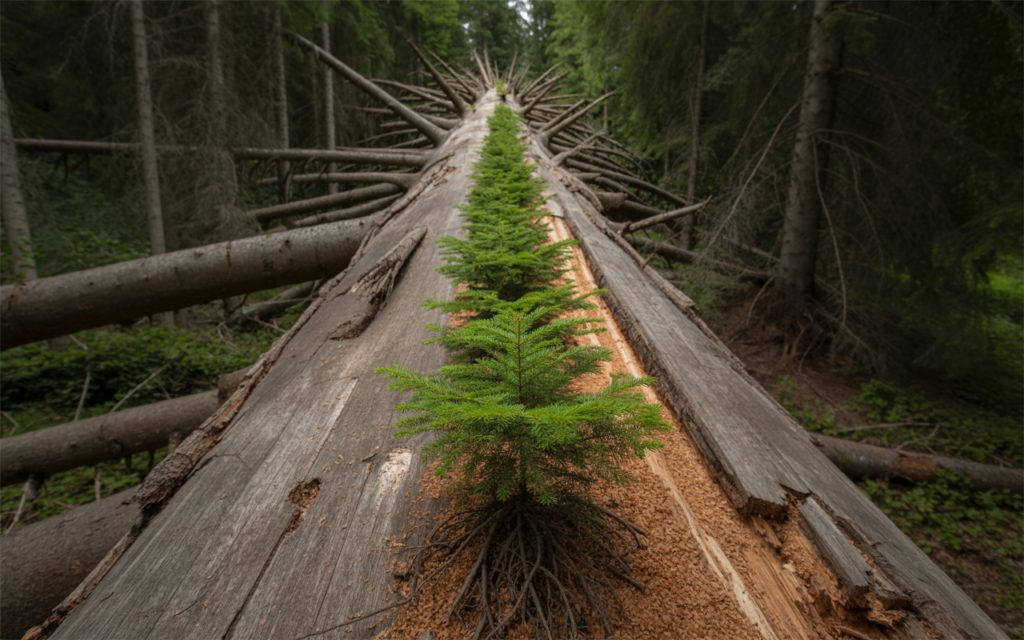
The Pioneers: First Life to Colonize a Log
The first residents to arrive on a fallen log are not the leafy green plants we might first imagine. The initial stage of colonization is dominated by organisms that specialize in breaking down the tough materials of the wood itself. Answering what plants often live on a log begins with these crucial pioneers.
Fungi and Mushrooms: The Master Decomposers
Fungi are the undisputed champions of wood decomposition. They are the primary agents responsible for breaking down the two most complex and durable components of wood: lignin and cellulose. By secreting powerful enzymes, fungi slowly transform the hard, solid wood into a soft, spongy, nutrient-rich material. Many of these fungi produce visible fruiting bodies, which we know as mushrooms. Let’s differentiate a bit. White-rot fungi are the most beneficial for future plant life because they break down both lignin and cellulose, leaving a soft, fibrous, nutrient-rich base. Brown-rot fungi primarily consume cellulose, leaving behind crumbly, brown lignin. The activity of these fungi is the first step in understanding what plants often live on a log.
Mosses and Lichens: The Living Carpet
Once the fungi have begun to soften the wood, mosses and lichens are often the next to arrive. These hardy, non-vascular plants are perfectly adapted to clinging to the surface of the log.
- Mosses: Beyond just holding water, the thick mat of moss insulates the log, protecting it from extreme temperature swings and creating a stable, moist microclimate essential for the germination of other seeds. The lush green covering is a classic part of the image of what plants often live on a log.
- Lichens: A fascinating symbiotic organism made of a fungus and an alga living together, lichens are incredibly resilient and can grow on almost any surface. On a log, they contribute to the breakdown of bark and can even fix nitrogen from the atmosphere, adding this crucial nutrient to the decaying wood as they die and decompose themselves.
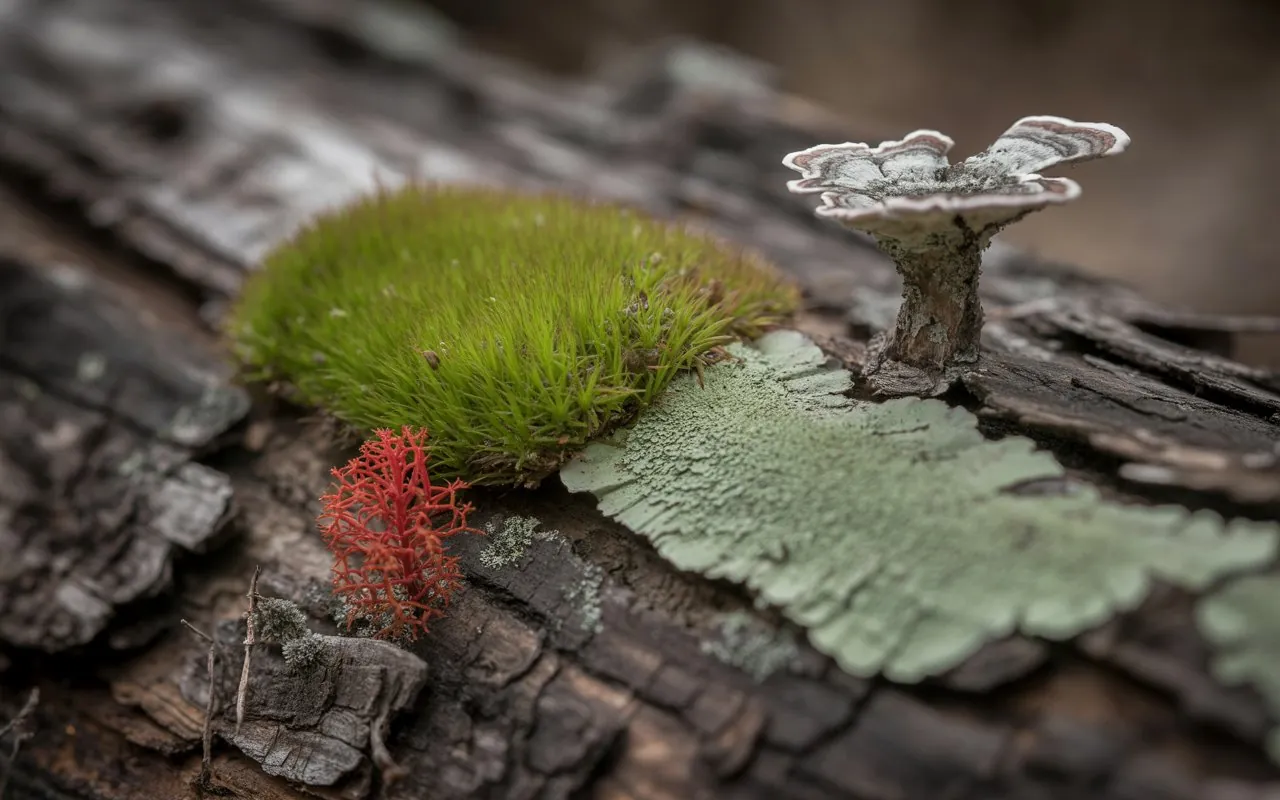
The Stages of Life on a Log
The transformation of a fallen tree into a thriving nursery is a slow process that occurs in distinct stages. Each stage provides a different answer to the question of what plants often live on a log.
Stage 1 – The Intact Log (Years 0-5)
In the immediate years after falling, the log is still hard with its bark mostly intact. At this point, the answer to what plants often live on a log is very limited. Life is restricted to hardy lichens and some surface-level fungi that can gain a foothold on the bark.
Stage 2 – The Colonization Stage (Years 5-15)
As moisture seeps in and fungi begin their work, the bark starts to peel and soften. This creates more surface area and texture, allowing mosses to establish themselves in the crevices. The log starts to act more like a sponge, and we see a greater diversity of fungi. At this stage, what plants often live on a log expands to include this foundational green carpet.
Stage 3 – The Nurse Log Stage (Years 15-50)
This is the prime stage for a nurse log. The wood has become soft, spongy, and rich with nutrients. The moss carpet is thick and lush. Now, the answer to what plants often live on a log becomes much more exciting. The log can support the growth of ferns, wildflowers, and most importantly, the seedlings of large forest trees.
Stage 4 – The Final Stage (Years 50+)
The log has now mostly crumbled and is becoming incorporated into the forest soil itself. The plants that started their life on the log now have their roots firmly in the ground below. Often, you can see the “ghost” of the log—a straight line of mature trees, their raised root systems tracing the outline of the long-vanished tree that gave them their start. The legacy of what plants often live on a log can last for centuries.
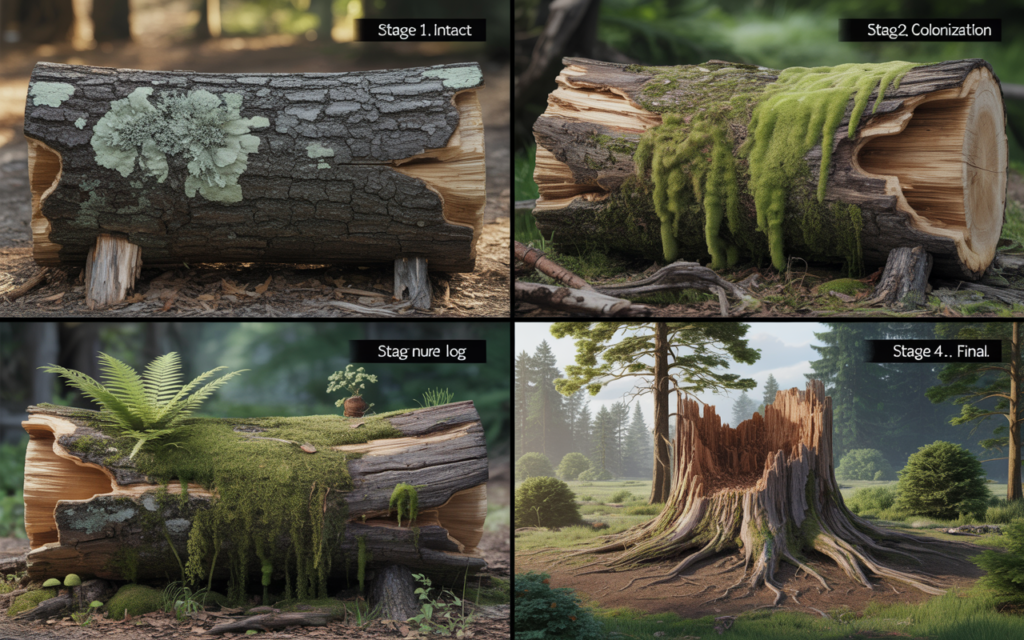
Main Inhabitants: What Plants Often Live on a Log
With the log softened by fungi and kept moist by a blanket of moss, it is now ready to host a wider variety of vascular plants. The presence of these larger plants is a clear sign that the log has become a fully functional nurse log. The table below outlines the most common inhabitants that answer the question, what plants often live on a log.
| Plant Type | Description & Role on the Log | Common Examples |
|---|---|---|
| Fungi | The primary decomposers. They break down the tough cellulose and lignin in wood, making nutrients available and softening the structure for other plants. | Bracket Fungi, Oyster Mushrooms, Turkey Tail |
| Mosses | Act as a living, water-retentive carpet. They keep the log moist, provide a stable seedbed, and contribute to the nutrient cycle as they decompose. | Cushion Moss, Fern Moss, Haircap Moss |
| Lichens | Hardy pioneers that can grow on bare bark. They contribute to the breakdown of the log’s surface and can add nutrients like nitrogen to the system. | British Soldiers Lichen, Shield Lichen |
| Ferns | Their tiny spores easily find purchase in the soft, moist wood. They thrive in the sheltered microclimate of the nurse log, adding lush greenery. | Christmas Fern, Maidenhair Fern, Cinnamon Fern |
| Tree Seedlings | The ultimate beneficiaries. They find a nutrient-rich, moist, and elevated position, giving them a head start over competitors on the forest floor. | Hemlock, Spruce, Fir, Birch |
A Living Ecosystem: More Than Just Plants
It’s important to understand that a decaying log is not just a home for plants; it is a bustling, self-contained ecosystem teeming with a huge diversity of life, all of which contributes to the process. The full picture of what plants often live on a log must include their non-plant neighbors.
- Insects and Invertebrates: Termites and beetle larvae tunnel through the wood, aerating it and hastening decomposition. Centipedes, millipedes, isopods (pill bugs), and spiders find shelter and hunt for food within its protective confines.
- Amphibians and Reptiles: Salamanders and skinks are often found under or inside moist, rotting logs, where they can stay cool and damp and find a ready supply of insects to eat.
- Small Mammals: Squirrels, chipmunks, and other small mammals may use logs for shelter or as a place to store food, helping to mix the decaying wood and introduce new seeds.
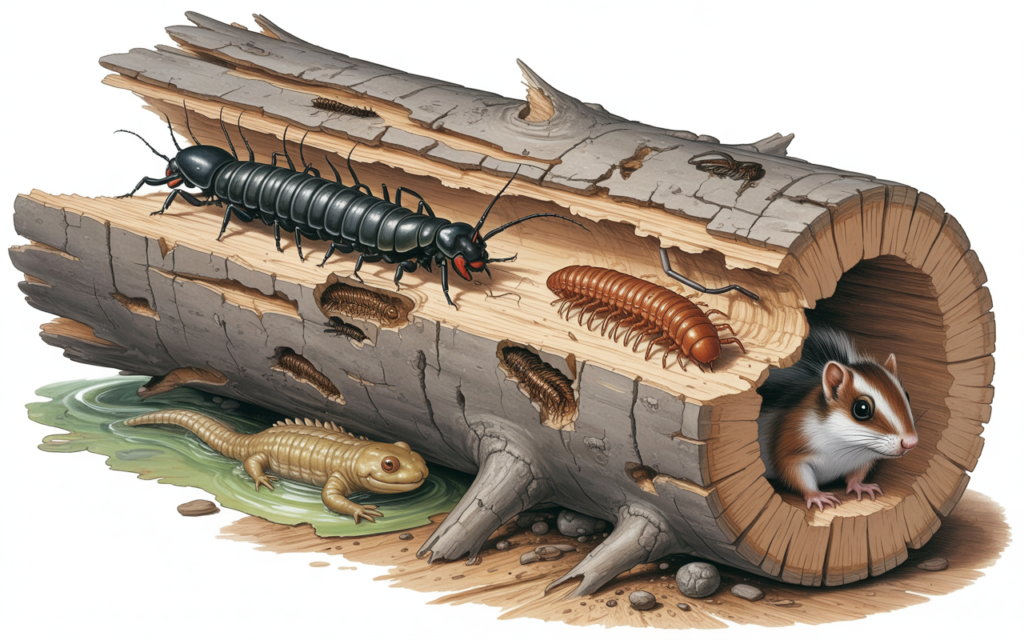
Creating Your Own Nurse Log Planter
You don’t have to go to an old-growth forest to appreciate this natural phenomenon. You can recreate the magic in your own garden. Understanding what plants often live on a log can inspire your own gardening projects.
Step 1: Find a Suitable Log
The ideal log will already have started to decompose. Hardwoods like oak will last longer, while softwoods like pine will break down faster. Always be careful when handling heavy logs.
Step 2: Hollow Out a Section
Using tools like a chisel, an adze, or even a drill with a large spade bit, carefully hollow out a section or several pockets on the top surface of the log to act as planting cavities.
Step 3: Fill with a Growing Medium
Fill the hollowed-out sections with a good quality potting mix or compost. This will give your plants an initial boost of nutrients.
Step 4: Choose Your Plants
Select plants that mimic what plants often live on a log in the wild, based on your garden’s conditions.
- For Shady Spots: Mosses, ferns, small hostas, bleeding hearts, or heucheras are excellent choices.
- For Sunnier Spots: Succulents like hens and chicks or various creeping sedums can thrive, as the wood helps retain moisture while still providing good drainage.
Step 5: Plant and Water
Arrange your chosen plants in the cavities, backfilling with more soil. Water them generously to help them get established. This project is a beautiful way to explore what plants often live on a log.
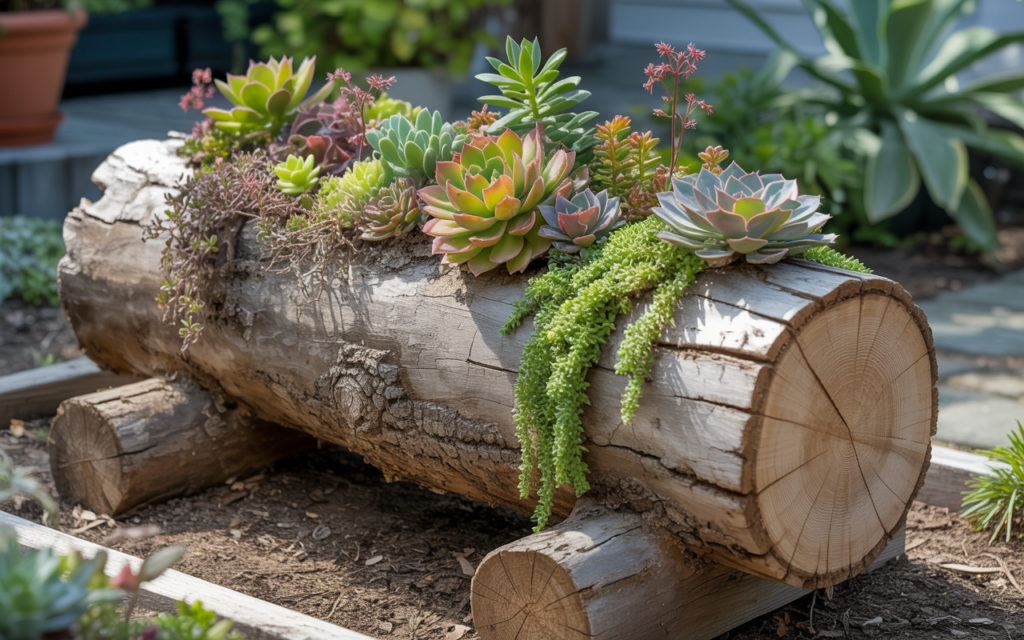
Frequently Asked Questions (FAQs)
Q: What is a nurse log?
A: A nurse log is a fallen, decaying log that provides a moist, nutrient-rich, and sheltered environment for new seeds and plants to grow, effectively “nursing” the next generation of forest life. It’s the primary reason we can find such a diverse answer to what plants often live on a log.
Q: How long does it take for plants to grow on a log?
A: It depends on the type of wood and the climate. Fungi and mosses can appear within a year, but it can take 5-10 years or more for the log to decay enough to support larger plants like ferns and tree seedlings.
Q: Can I use any type of log for a garden planter?
A: Hardwoods like oak or maple will last longer but take more time to decay. Softwoods like pine will break down faster, making them a quicker option for a naturalistic planter. Avoid treated wood (e.g., from old railroad ties or utility poles), as the chemicals can be harmful to your plants.
Q: Does the type of tree the log came from matter?
A: Yes. Some woods, like cedar, are naturally rot-resistant and will take much longer to become hospitable. The pH of the decaying wood can also vary by species, which can influence what plants often live on a log that has fallen.
Q: Are the mushrooms that grow on logs safe to eat?
A: Never eat a mushroom unless you are 100% certain of its identification and edibility. Many mushrooms are poisonous, and some edible species have toxic look-alikes. It is safest to assume all wild mushrooms are inedible unless confirmed by an expert.
Conclusion: The Enduring Life of a Fallen Tree
We began with a simple question: what plants often live on a log? As we have seen, the answer is a rich and diverse community, from the microscopic fungi that do the initial heavy lifting to the towering trees that owe their very existence to the legacy of their fallen ancestors.
A rotting log is a testament to the fact that in nature, there is no such thing as waste. Every end is a new beginning. These nurse logs are the quiet, unsung heroes of the forest, acting as cradles for new life, reservoirs of moisture, and hubs of biodiversity. They remind us that strength and vitality can be found not just in the living and the growing, but in the decaying and the decomposing as well.
The next time you see a fallen tree covered in a carpet of green moss and dotted with delicate ferns, you’ll see it not as a relic, but as a thriving metropolis—a complete and perfect answer to the question of what plants often live on a log. This understanding transforms a simple observation into a deep appreciation for the cycles of life, proving that even in death, a tree’s work is far from over. The real beauty is in knowing that what plants often live on a log is the forest of tomorrow.